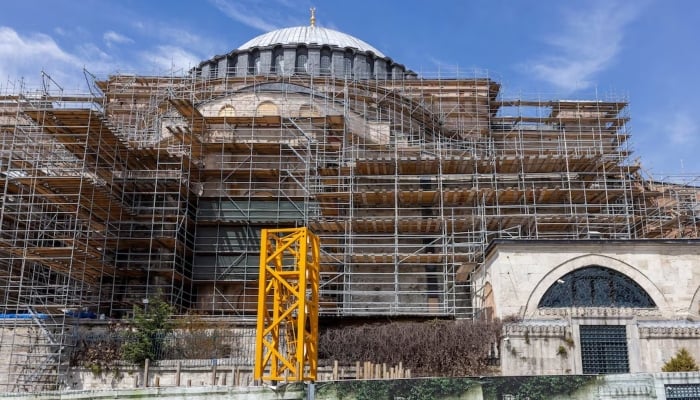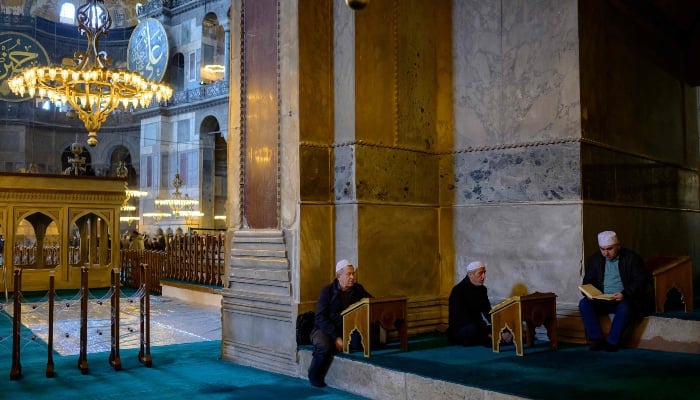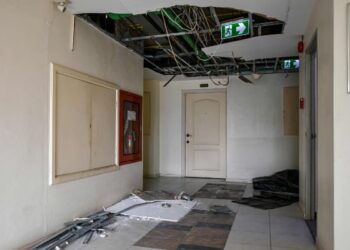ISTANBUL: The Hagia Sophia in Istanbul is no stranger to transformations. Over its long history, this architectural masterpiece has transitioned from a church to a mosque, then to a museum, and back to a mosque once more.
The current renovation project is designed not only to preserve the marvelous structure that has stood for 1,488 years but also to fortify it against the next earthquake that may strike this ancient city.
From a distance, its magnificent dome, radiant stone, and elegant minarets continue to grace the Istanbul skyline, as they have for centuries.
However, as visitors approach, they notice scaffolding enveloping its eastern facade and one of the minarets.
While “the renovations do somewhat disrupt the exterior atmosphere” and “the scaffolding detracts from the monument’s aesthetics… repairs are crucial,” commented Abdullah Yilmaz, a tour guide.
Hagia Sophia, a UNESCO World Heritage Site, is Turkey’s most frequented landmark. However, it “constantly faces various challenges,” noted Hasan Firat Diker, an architecture professor involved in the restoration efforts, in an interview with AFP. This is why the structure has undergone numerous repairs throughout the centuries.
A ‘Global’ Restoration
This renovation marks the first instance of a comprehensive restoration, affecting the dome, walls, and minarets, Diker explained.

Upon its completion in AD 537, built on the site of previous churches, the Hagia Sophia became a beacon of Byzantine architectural excellence during the era when the city was known as Constantinople.
It functioned as a church until the city fell to the Ottomans in 1453, and it was then converted into a mosque.
In 1935, Mustafa Ataturk, the architect of modern Turkey who transformed the nation into a secular state, designated the building as a museum.
This status persisted until 2020, when President Recep Tayyip Erdogan, a practicing Muslim associated with an Islamist-rooted party, restored its function as a mosque.
Prepared for the Next Earthquake
The Hagia Sophia, like many structures in this historically rich city, is not only influenced by its rulers but also faces the persistent threat of earthquakes. The last significant quake occurred in 1999.

Located just a few kilometers from a seismic fault line, Hagia Sophia does not adhere to modern earthquake safety standards. The dome collapsed during an earthquake in 558, and the building has since suffered damage from subsequent quakes.
The primary objective of the ongoing restoration is to “strengthen the structure in preparation for the next major earthquake,” ensuring that the ancient monument “endures with minimal damage,” stated Ahmet Gulec, a member of the scientific committee overseeing the project.
At this stage, experts are examining the dome to devise the best strategies for reinforcement and restoration, according to Diker.
The interior currently remains free of scaffolding, but eventually, four large pillars will be installed inside to support a platform for specialists to repair the dome’s paintings and mosaics.
“Once you’re inside, it’s amazing,” exclaimed Ana Delgado, a 49-year-old tourist from Mexico, as she absorbed the lively ambiance filled with laughter and conversation following afternoon prayers.
“It’s enchanting,” added her friend, Elias Erduran, who hails from the Dominican Republic.
A Popular Destination
Last year, Hagia Sophia welcomed a remarkable 7.7 million visitors.

Approximately 2.1 million were international tourists, many of whom paid 25 euros for an entry ticket, contributing to substantial annual revenue.
Officials are hopeful that the construction work won’t discourage people from visiting during this extensive renovation, which is expected to last several years. The total cost of the project has not been disclosed.
“Our aim is for visits and prayers to continue throughout the renovation,” Gulec emphasized.
Even if some visitors are disappointed that they cannot fully appreciate the building’s grandeur, the key takeaway is that “one day, my children will also get to experience the beauty of Saint Sophia,” said Yana Galitskaya, a 35-year-old visitor from Russia.





